Door
![]()
This article deals with the architectural element. For the Bundeswehr project, see TÜR. For the feature film The Door, see The Door.
![]()
This article or section is still missing the following important information:
Historically and worldwide, there is an extreme variety of forms for door leaves and door frames. Unfortunately, the article provides almost no information regarding anatomy, design, framing and congruence with the architectural style of the house.
Help Wikipedia by researching and adding them.
A door, especially in upper and middle German also Türe, is a movable building element for closing an opening (of a wall, wall, passage or entrance), which after opening allows the passage or climb through. A distinction is made between exterior and interior doors. A door usually has an upright format. Wings that serve the passage of vehicles are also called a gate. A leaf that is installed horizontally or at an angle is often called a flap.
Sashes which are not suitable for passing through or through are called shutters or flaps, unless they are used for lighting. Otherwise they are called windows.
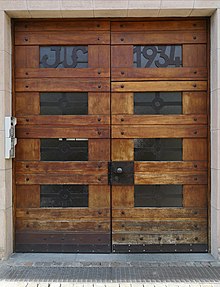
Entrance door in Bolzano (Grieser Platz) from 1934 with elements of wood, glass and iron

Door of the parish church St. Gallus and Ulrich in Kißlegg with insert door, numerous functional fittings and setting (painting)

Wall cutout for a door in the shell

Commercially available (right-hinged) interior door with frame
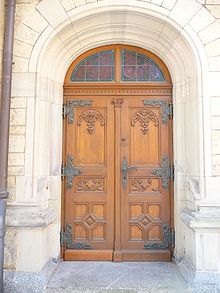
Wooden door on the side portal of the protestant Christuskirche in Heidelberg
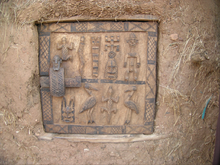
Simple door of the Dogon in Mali with a lock for access to a storage room; the ornaments originally had an apotropaic function.
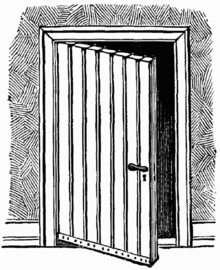
simple door of wood slats
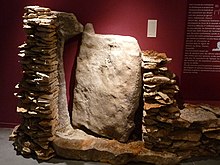
Stone door in a megalithic dolmen with lateral tenons
Etymology
The word Tür, Old High German turi, Middle High German tür(e), has been documented since the 8th century. Originally it occurred only in the dual, later in the plural, and was reinterpreted in German into a new singular. Like Old Icelandic dyrr (plural) and Old English duru (plural), it goes back to Urgermanic dur-, which in turn is an ablaut of Indo-European dhwer- (cf. Greek thýra, Latin forēs).
History
The first dwellings built by humans of wickerwork, wooden posts, mud, or stone usually had no lockable entrance doors; for protection against the intrusion of domestic animals or predators, the presence of a movable wickerwork lattice of twigs in the lower half is probable. Door closures, like window openings, appear later. Interior doors were equally non-existent. Ancient and medieval doors usually had lateral pivots anchored in matching cavities in the sill and lintel.
During the rescue excavations at the Zurich Opera House in 2010, the most important single find was an approximately 5000-year-old wooden door, which could go down in history as the third oldest door in Switzerland and probably in Europe. The Zurich door is similar to the second oldest example found in Pfäffikon ZH. It is much better preserved and consists of three boards held together by sophisticated connectors. The door hinge is also preserved.
Search within the encyclopedia